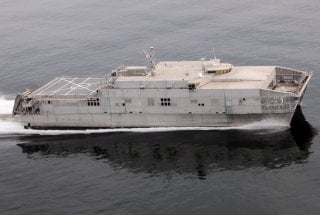Meet the U.S. Navy's Newest Fast Transport (It Can Haul a Small Fleet of Tanks)
It will quickly ferry men, supplies, and tanks all over the globe.
The U.S. Navy will soon deploy another super high-speed vessel able to transport 600 tons of troops, weapons, equipment, ammo and even a small fleet of seventy-ton Abrams tanks to war. This transport will change the scope and nature of coordinated amphibious attack.
The service’s 12th Expeditionary Fast Transport (EPF) ship, the USNS Newport, recently completed what’s called Integrated Sea Trials, an assessment and demonstration exercise intended to prepare the ship for full-scale operations by conducting maneuvers, transport missions and some reconnaissance operations. By traveling at fast-speeds of thirty-five knots and over distances as far as 1,200 miles, the new ships bring new dimensions to the Navy’s increasingly expeditionary warfare strategy.
While classified as “non-combatant” ships, the EPF ships are not themselves armed with weapons but engineered for fast humanitarian transport, disaster relief and other high-speed missions. However, make no mistake, the ships are planned for major combat operations as well, as they can “roll-on/roll-off” armored vehicles, large numbers of armed soldiers or marines and, if needed, a group of drones.
For instance, an ability to transport a group of Abrams tanks brings a huge advantage to Army, Navy and Marine Corps forces, because deploying and preparing heavily armored vehicles for land assault is extremely difficult.
The Army, in particular, is taking major steps toward becoming more expeditionary and faster to deploy. Abrams tanks, specifically, add to these challenges. They are very heavy, not air-transportable and difficult to mobilize.
Accordingly, an ability to fast-track five or more main battle tanks to combat delivers unprecedented deployment capability. With this kind of high-speed transport, it is not too much of a stretch to consider that Abrams tanks and other large combat vehicles could much more easily support amphibious attacks from ship-to-shore.
While Marine Corps amphibious assault ships are built to swim as well as fight ashore, an ability to supplement, fortify or strengthen land attack from the ocean dramatically changes the tactical equations for commanders who might otherwise need weeks to prepare for a heavily-armored land invasion.
Existing Navy Ship-to-Shore connectors can transport Abrams tanks, yet one at a time. Having EPFs makes things faster. A heavy armored attack from the sea, enabled by EPFs, would also help secure the beachhead for large amounts of follow-on attack forces.
Perhaps a future massive amphibious assault would use EPFs carrying tanks, 155 towed artillery, thousands of soldiers, new Optionally Manned Fighting Vehicle infantry carriers and ground-attack robots. Such an attack would happen in coordination with overhead F-35 and F-22 air support, suppressive fire from land-attack Navy surface ships and scores of Amphibious Assault Vehicles traveling from ship to shore.
Such a prospect gives new meaning to multi-domain warfare possibilities as there will soon be twelve operational EPFs. As one Navy report said, “The USNS Newport is on track to deliver later this year. Austal USA has also started construction of the future USNS Apalachicola (EPF 13) and is under contract to build the future USNS Cody (EPF 14).”
Kris Osborn is Defense Editor for the National Interest. Osborn previously served at the Pentagon as a Highly Qualified Expert with the Office of the Assistant Secretary of the Army—Acquisition, Logistics & Technology. Osborn has also worked as an anchor and on-air military specialist at national TV networks. He has appeared as a guest military expert on Fox News, MSNBC, The Military Channel, and The History Channel. He also has a Masters Degree in Comparative Literature from Columbia University.
Image: Austal

